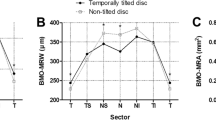Abstract
Purpose To evaluate retinal thickness and function in eyes with tilted disc syndrome with optical coherence tomography (OCT) and multifocal electroretinogram (mfERG). Methods Twenty-one eyes of 12 patients (4 males and 8 females) with tilted disc were studied with OCT3 and mfERG and compared with 40 eyes of 20 age and sex-matched control subjects. The thickness of the fovea and the thickness of retinal nerve fibre layer (RNFL) along a 3.4-mm-diameter circle centred on the optic nerve head were evaluated using OCT3. The macular cone function was tested by mfERG. Results The OCT-derived RNFL thickness was significantly decreased in the superior area of eyes with tilted disc with a mean value equal to 106.47 μm (SD 24.1). The mean response amplitude density of the fovea (11.75 nV/deg²) and parafovea (8.22 nV/deg²) was significantly lower in eyes with tilted disc than in normal eyes. Conclusion OCT and mfERG can be objective tools for assessing anatomical and functional damage of the macula. Our results suggest that in tilted disc syndrome even without visual impairment the optic nerve and the macula show dysfunction not visible by other means.



Similar content being viewed by others
References
Young SE, Walsh FB, Knox DL (1976) The tilted disc syndrome. Am J Ophthalmol 82:16–23
Dorrel D (1978) The tilted disc. Br J Ophthalmol 62:15–20
Apple DJ, Rabb MF, Walsh PM (1982) Congenital anomalies of the optic disc. Surv Ophthalmol 27:2–41
Giuffre G (1982) Chorioretinal degenerative changes in the tilted disc syndrome. Int Ophthalmol 15:1–9
Stur M (1988) Congenital tilted disc syndrome with parafoveal subretinal neovascularization. Am J Ophthalmol 105(1):98–99
Prost M, DeLaey JJ (1988) Choroidal neovascularization in tilted disc syndrome. Int Ophthalmol 12:131–135
Leys AM, Cohen SY (2002) Subretinal leakage in myopic eyes with a posterior staphyloma or tilted disc syndrome. Retina 22:659–665
Moschos MM, Margetis I, Papadimitriou S, Tzeni Z, Moschos MN (2007) Clinical and multifocal-electroretinographic findings of congenital tilted disc syndrome associated with choroidal neovascularization. Doc Ophthalmol 85:653–657
Cohen SY, Quentel G, Guiberteau B, Delahaye-Mazza C, Gaudric A (1998) Macular serous retinal detachment caused by leakage in tilted disc syndrome. Ophthalmology 105:1831–1834
Tosti G (1998) Serous macular retinal detachment and tilted disc syndrome. Ophthalmology 106:1453–1455
Lakshminarayanan V, Bailey JE, Enoch JM (1997) Photoreceptor orientation and alignment in nasal fundus ectasia. Optom Vis Sci 74:1011–1018
Vuori ML, Mantyjarvi M (2007) Tilted disc syndrome and color vision. Acta Ophthalmol 85:648–652
Sutter E, Tram D (1992) The field topography of ERG components in man—I. The photopic luminance response. Vis Res 32:433–446
Hood DC (2000) Assessing retinal function with the multifocal technique. Prog Retin Eye Res 19:607–646
Hood DC, Bach M, Brigell M et al (2008) ISCEV guidelines for clinical electroretinography (2007 edition). Doc Ophthalmol 116:1–11
Hamada T, Tsukada T, Hirose T (1987) Clinical and electrophysiological features of tilted disc syndrome. Jpn J Ophthalmol 31:265–273
Author information
Authors and Affiliations
Corresponding author
Rights and permissions
About this article
Cite this article
Moschos, M.M., Triglianos, A., Rotsos, T. et al. Tilted disc syndrome: an OCT and mfERG study. Doc Ophthalmol 119, 23–28 (2009). https://doi.org/10.1007/s10633-009-9165-x
Received:
Accepted:
Published:
Issue Date:
DOI: https://doi.org/10.1007/s10633-009-9165-x




